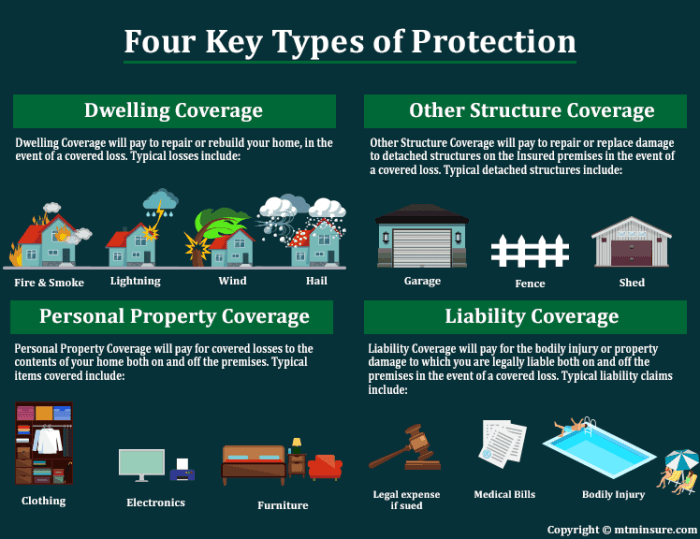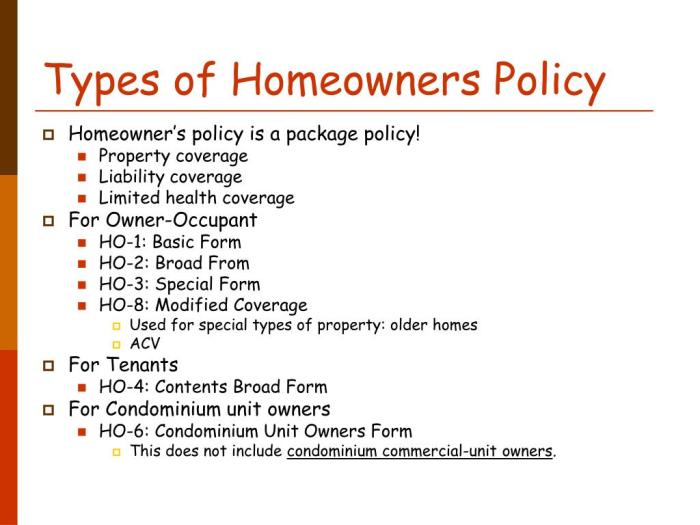What are the different types of homeowners insurance? It’s a question that pops up when you’re buying a house, and rightfully so! You’re investing a big chunk of change, and you want to make sure you’re covered. Homeowners insurance is your safety net, protecting you from financial ruin in case of unexpected events like fires, theft, or natural disasters.
But with so many different types of policies, it can be tough to know which one is right for you. That’s where we come in.
We’ll break down the different types of homeowners insurance policies, explaining the coverage they offer and highlighting the key differences. We’ll also discuss factors that influence insurance costs, common coverage components, and additional optional coverage options. By the end of this guide, you’ll be equipped to choose the policy that best fits your needs and budget.
Introduction to Homeowners Insurance

Homeowners insurance is a crucial aspect of protecting your most valuable asset – your home. It acts as a financial safety net, shielding you from the potential financial burden of unexpected events that could damage your property or cause personal liability.
Homeowners insurance is a type of property insurance that covers your home and its contents against various risks. It provides financial protection in case of unforeseen events such as fires, storms, theft, or vandalism.
Common Risks Covered by Homeowners Insurance, What are the different types of homeowners insurance
A standard homeowners insurance policy typically covers a range of common risks, including:
- Fire and Lightning:Covers damage caused by fire, including smoke and water damage from firefighting efforts.
- Windstorms and Hail:Protects against damage from strong winds, tornadoes, and hailstorms.
- Theft and Vandalism:Offers coverage for stolen or vandalized property, including personal belongings.
- Other Perils:Includes coverage for various other perils like explosions, riots, and falling objects.
Components of a Homeowners Insurance Policy
A typical homeowners insurance policy consists of several key components:
- Dwelling Coverage:Covers the structure of your home, including the foundation, walls, roof, and attached structures.
- Other Structures Coverage:Provides coverage for detached structures like garages, sheds, and fences.
- Personal Property Coverage:Protects your belongings inside your home, including furniture, electronics, clothing, and other personal items.
- Liability Coverage:Offers financial protection if you are held liable for injuries or property damage to others on your property.
- Additional Living Expenses:Covers temporary housing and living expenses if you are unable to live in your home due to a covered event.
Closing Notes: What Are The Different Types Of Homeowners Insurance

So, you’ve learned about the different types of homeowners insurance, the factors that influence costs, and the key coverage components. Now, it’s time to take action! Start by researching insurance providers in your area and comparing quotes. Don’t hesitate to ask questions and seek guidance from an insurance agent or broker.
They can help you understand your options and choose the policy that provides the right level of protection for your home and your peace of mind.
FAQ Insights
What is the difference between actual cash value and replacement cost coverage?
Actual cash value (ACV) coverage pays for the depreciated value of your damaged property, while replacement cost coverage pays for the full cost of replacing your property with a new one. ACV coverage is typically less expensive, but it can leave you with a significant financial gap if your property is severely damaged.
What are some common exclusions in homeowners insurance policies?
Homeowners insurance policies typically exclude coverage for certain risks, such as earthquakes, floods, and acts of war. You may need to purchase additional coverage for these risks separately.
How can I lower my homeowners insurance premiums?
There are a number of things you can do to lower your homeowners insurance premiums, such as installing security systems, smoke detectors, and fire extinguishers. You can also consider increasing your deductible or making other changes to your policy.
